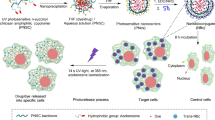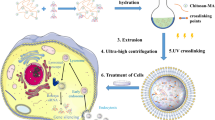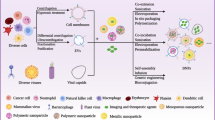Abstract
Non-viral vesicle composing of low-molecular weight polyethylenimine-conjugated stearic acid-g-chitosan oligosaccharide (CSOSA-g-PEI) was synthesized for gene delivery and therapy. The synthesized CSOSA-g-PEI had good ion-buffer capabilities and DNA-binding capacity, which could form positively charged nano-sized particles (100–150 nm) with plasmid DNA; in vitro gene transfection tests demonstrated that CSOSA-g-PEI presented much lower cytotoxicity and corresponding transfection efficiency in comparison with Lipofectamine 2000 in both human cancer cells (Hela and MCF-7). The gene transfection of CSOSA-g-PEI/pDNA could be further enhanced in the presence of serum or by adding arginine during incubation of CSOSA-g-PEI micelles with plasmid DNA. The biodistribution experiments demonstrated CSOSA-g-PEI conjugate highly localized in the tumor tissue and indicated a persistently increased accumulation. In vivo antitumor activity results showed that CSOSA-g-PEI/plasmid pigment epithelium-derived factor formulation could effectively suppress the tumor growth (above 60% tumor inhibition) without systematic toxicity against animal body after intravenous injection.
This is a preview of subscription content, access via your institution
Access options
Subscribe to this journal
Receive 12 print issues and online access
$259.00 per year
only $21.58 per issue
Buy this article
- Purchase on Springer Link
- Instant access to full article PDF
Prices may be subject to local taxes which are calculated during checkout






Similar content being viewed by others
References
Chae SY, Son S, Lee M, Jang MK, Nah JW . Deoxycholic acid-conjugated chitosan oligosaccharide nanoparticles for efficient gene carrier. J Control Rel 2009; 109: 330–344.
Kiang T, Wen J, Lim HW, Leong KW . The effect of the degree of chitosan deacetylation on the efficiency of gene transfection. Biomaterials 2004; 25: 5293–5301.
Zauner W, Ogris M, Wagner E . Polylysine-based transfection systems utilizing receptor-mediated delivery. Adv Drug Deliv Rev 1998; 30: 97–113.
Kang HC, Kim S, Lee M, Bae YH . Polymeric gene carrier for insulin secreting cells: poly(L-lysine)-g-sulfonylurea for receptor mediated transfection. J Control Rel 2005; 105: 164–176.
Orig M, Brunner S, Schuller S, Kircheis R, Wagner E . PEGylated DNA/transferring-PEI complexes: reduced interaction with blood components, extended circulation in blood and potential for systemic gene delivery. Gene Ther 1999; 6: 595–605.
Kim TH, Kim SI, Akaikeb T, Cho CS . Synergistic effect of poly(ethylenimine) on the transfection efficiency of galactosylated chitosan/DNA complexes. J Control Rel 2005; 105: 354–366.
Behr JP . Gene transfer with synthetic cationic amphiphiles: prospects for gene therapy. Bioconjugate Chem 1994; 5: 382–389.
Yu JH, Quan JS, Huang J, Wang CY, Su B, Nah JW et al. α, β-Poly(L-aspartate-graft-PEI): a pseudo-branched PEI as a gene carrier with low toxicity and high transfection efficiency. Acta Biomaterials 2009; 5: 2485–2494.
Ma K, Hu MX, Qi Y, Qiu LY, Jin Y, Yu JM et al. Structure–transfection activity relationships with glucocorticoid–polyethylenimine conjugate nuclear gene delivery systems. Biomaterials 2009; 30: 3780–3789.
Boussif O, Lezoualc’h F, Zanta MA, Mergny MD, Scherman D, Demeneix B et al. A versatile vector for gene and oligonucleotide transfer into cells in culture and in vivo: polyethylenimine. Proc Natl Acad Sci USA 1995; 92: 7297–7303.
Awson DW, Volpert OV, Gillis P, Crawford SE, Xu H, Benedict W et al. Pigment epithelium-derived factor: a potent inhibitor of angiogenesis. Science 1999; 285: 245–248.
Dass CR, Contreras KG, Dunstan DE, Choong P . Chitosan microparticles encapsulating PEDF plasmid demonstrate efficacy in an orthotopic metastatic model of osteosarcoma. Biomaterials 2007; 28: 3026–3033.
Abe R, Shimizu T, Yamagishi S, Shibaki A, Amano S, Inagaki Y et al. Overexpression of pigment epithelium-derived factor decreases angiogenesis and inhibits the growth of human malignant melanoma cells in vivo. Am J Pathol 2004; 164: 1225–1232.
You J, Hu FQ, Du YZ, Yuan H . Polymeric micelles with glycolipid-like structure and multiple hydrophobic domains for mediating-target delivery of paclitaxel. Biomacromolecules 2007; 8: 2450–2456.
Hu FQ, Zhao MD, Yuan H, You J, Du YZ, Zeng S . A novel chitosan oligosaccharide–stearic acid micelles for gene delivery: properties and in vitro transfection studies. Int J Pharm 2006; 315: 158–166.
Hu FQ, Liu LN, Du YZ, Yuan H . Synthesis and antitumor activity of doxorubicin conjugated stearic acid-g-chitosan oligosaccharide polymeric micelles. Biomaterials 2009; 30: 6955–6963.
Suk JS, Suh J, Choy K, Lai SK, Fu J, Hanes J . Gene delivery to differentiated neurotypic cells with RGD and HIV Tat peptide functionalized polymeric nanoparticles. Biomaterials 2006; 27: 5143–5150.
Liu G, Molas M, Grossmann GA, Pasumarthy M, Perales JC, Cooper MJ et al. Biological properties of poly-L-lysine–DNA complexes generated by cooperative binding of the polycation. J Biol Chem 2001; 276: 34379–34387.
Sonawane ND, Szoka FC, Verkman AS . Chloride accumulation and swelling in endosomes enhances DNA transfer by polyamine–DNA polyplexes. J Biol Chem 2003; 278: 44826–44831.
Petersen H, Fechner PM, Martin AL, Kunath K, Stolnik S, Roberts CJ et al. Polyethylenimine-graft-poly(ethylene glycol) copolymers: influence of copolymer block structure on DNA complexation and biological activities as gene delivery system. Bioconjugate Chem 2002; 13: 845–854.
Mislick KA, Baldeschwieler JD . Evidence for the role of proteoglycans in cation-mediated gene transfer. Proc Natl Acad Sci USA 1996; 93: 12349–12354.
Gao Y, Xu ZH, Chen SW, Gu WW, Chen LL, Li YP . Arginine-chitosan/DNA self-assemble nanoparticles for gene delivery: In vitro characteristics and transfection efficiency. Int J Pharm 2008; 359: 241–246.
Yamanouchi D, Wu J, Lazar AN, Craig KK, Chu CC, Liu B . Biodegradable arginine-based poly(ester-amide)s as non-viral gene delivery reagents. Biomaterials 2008; 29: 3269–3277.
Jiang HL, Kim YK, Arote R, Nah JW, Cho MH, Choi YJ et al. Chitosan-graft-polyethylenimine as a gene carrier. J Control Rel 2007; 117: 273–280.
Yla’’-Herttuala S, Rissanen TT, Vajanto I, Hartikainen J . Vascular endothelial growth factors: biology and current status of clinical applications in cardiovascular medicine. J Am Coll Cardiol 2007; 49: 1015–1026.
Yamagishi S, Matsui T, Inoue H . Inhibition by advanced glycation end products (AGEs) of pigment epithelium-derived factor (PEDF) gene expression in microvascular endothelial cells. Drugs Exp. Clin Res 2005; 31: 227–232.
Witmer AN, Vrensen GF, Van-Noorden CJ, Schlingemann RO . Vascular endothelial growth factors and angiogenesis in eye disease. Prog Retin Eye Res 2003; 22: 1–29.
Yoshinobu F, Hideki I . Nanoparticles for cancer therapy and diagnosis. Adv Powder Technol 2006; 17: 1–28.
Dash PR, Read ML, Barrett LB, Wolfert MA, Seymour LW . Factors affecting blood clearance and in vivo distribution of polyelectrolyte complexes for gene delivery. Gene Therapy 1999; 6: 643–650.
Fenske DB, MacLachlan I, Cullis PR . Long-circulating vectors for the systemic delivery of genes. Curr Opin Mol Ther 2001; 3: 153–158.
Vold IMN, Christensen BE . Periodate oxidation of chitosans with different chemical compositions. Carbohydr Res 2005; 340: 679–684.
Acknowledgements
This work is supported by the National Nature Science Foundation of China under Contract 30873174 and 81072583, and the Nature Science Foundation of Zhejiang province under Contract z207489 and Y2090336, and Zhejiang Provincial Program for the Cultivation of High-level Innovative Health Talents.
Author information
Authors and Affiliations
Corresponding author
Ethics declarations
Competing interests
The authors declare no conflict of interest.
Rights and permissions
About this article
Cite this article
Hu, FQ., Chen, WW., Zhao, MD. et al. Effective antitumor gene therapy delivered by polyethylenimine-conjugated stearic acid-g-chitosan oligosaccharide micelles. Gene Ther 20, 597–606 (2013). https://doi.org/10.1038/gt.2012.72
Received:
Revised:
Accepted:
Published:
Issue Date:
DOI: https://doi.org/10.1038/gt.2012.72
Keywords
This article is cited by
-
Nanomedicine in therapeutic warfront against estrogen receptor–positive breast cancer
Drug Delivery and Translational Research (2023)
-
Chitosan oligosaccharide modified liposomes enhance lung cancer delivery of paclitaxel
Acta Pharmacologica Sinica (2021)
-
Crosstalk between chitosan and cell signaling pathways
Cellular and Molecular Life Sciences (2019)
-
BMP2 gene delivery to bone mesenchymal stem cell by chitosan-g-PEI nonviral vector
Nanoscale Research Letters (2015)



